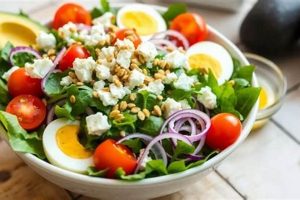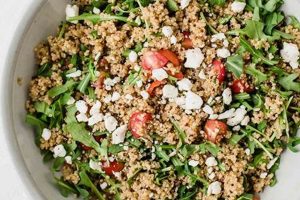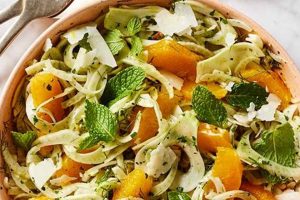Combining aquatic protein with fresh, raw, or lightly cooked vegetables offers a nutritionally balanced and often light meal option. A typical example might include grilled salmon fillets served over a bed of mixed greens with a lemon vinaigrette, or perhaps flaked tuna combined with chopped celery, onion, and a light mayonnaise dressing over crisp romaine lettuce. Variations are vast, encompassing different species of fish, diverse salad ingredients, and a wide range of dressings and preparations.
Meals featuring prepared aquatic proteins and vegetables contribute significantly to a healthy diet. Fish provides essential omega-3 fatty acids and high-quality protein, while salads offer vitamins, minerals, and fiber. This combination can support heart health, weight management, and overall well-being. Historically, the pairing of fish and vegetables has been a staple in various cultures, adapting to local ingredients and culinary traditions.
This article will explore the versatility of such meals, examining various cooking methods for the fish component, offering creative salad combinations, and providing guidance on selecting complementary dressings and accompaniments. Specific recipes will be presented, catering to different tastes and dietary needs.
Tips for Preparing Fish and Salad Meals
Optimizing the combination of fish and salad requires attention to detail in both preparation and ingredient selection. The following tips offer guidance for creating flavorful and nutritious meals.
Tip 1: Fish Selection: Choose high-quality, fresh fish appropriate for the desired cooking method. Firm, white-fleshed fish like cod or halibut are excellent for grilling or baking, while fattier fish such as salmon or tuna can be pan-seared or enjoyed raw in salads.
Tip 2: Cooking Methods: Employ cooking techniques that enhance the fish’s natural flavors without overcooking. Grilling, baking, poaching, and pan-searing are recommended methods. Avoid deep-frying, which can add unnecessary fat and detract from the lightness of the meal.
Tip 3: Salad Composition: Consider a variety of textures and flavors in the salad. Combine leafy greens with crunchy vegetables like cucumbers, bell peppers, or carrots. Add elements like nuts, seeds, or dried fruits for added nutritional value and textural contrast.
Tip 4: Dressing Selection: Choose dressings that complement both the fish and the salad ingredients. Light vinaigrettes, lemon juice, or herb-infused oils are generally preferred over heavy, creamy dressings.
Tip 5: Seasoning: Enhance the flavor profile of both the fish and the salad with appropriate seasonings. Fresh herbs, spices, and citrus zest can elevate the overall taste experience.
Tip 6: Balance and Proportion: Strive for a balance between the fish and salad components. The salad should complement the fish without overpowering it, creating a harmonious and satisfying meal.
Tip 7: Food Safety: Ensure proper food handling and storage practices, especially when working with raw fish. Maintain appropriate refrigeration temperatures and adhere to recommended cooking times to minimize the risk of foodborne illness.
By following these guidelines, individuals can create delicious and nutritious meals that highlight the complementary nature of fish and salad. These combinations offer a versatile approach to healthy eating, adaptable to diverse palates and dietary preferences.
This article will now present specific recipes incorporating these principles, offering practical examples of how to create delicious and healthy fish and salad meals.
1. Fresh, High-Quality Fish
The foundation of any successful fish and salad recipe lies in the selection of fresh, high-quality fish. This core ingredient dictates the overall flavor, texture, and nutritional value of the dish. Understanding the characteristics of fresh fish and its impact on the final product is crucial for creating a truly exceptional meal.
- Sensory Indicators of Freshness
Evaluating fish freshness involves careful sensory assessment. Clear, bright eyes, firm flesh that springs back when touched, and a fresh, mild sea aroma are key indicators. Gills should be bright red or pink. Avoid fish with cloudy eyes, dull or slimy skin, or a strong, fishy odor. These qualities directly influence the taste and texture of the finished salad, contributing to either a delightful or disappointing culinary experience.
- Species Selection and Culinary Application
Different fish species offer unique flavor profiles and textures, influencing their suitability for various salad preparations. Flaky white fish like cod or haddock lend themselves well to lighter salads with delicate dressings, while robust, oily fish like tuna or salmon can stand up to more assertive flavors and textures. Choosing the right species enhances the synergy between the fish and other salad components.
- Sourcing and Sustainability
Sourcing fish from reputable suppliers committed to sustainable fishing practices is essential for both ethical and culinary reasons. Sustainably sourced fish ensures the long-term health of fish populations and minimizes environmental impact. Moreover, fish caught using responsible methods often exhibit superior quality and flavor, contributing positively to the overall dish.
- Storage and Handling
Proper storage and handling of fresh fish are crucial for maintaining its quality and preventing bacterial growth. Refrigerate fish at or below 40F (4C) and use it within one to two days of purchase. Thawing frozen fish slowly in the refrigerator minimizes moisture loss and preserves texture. Adhering to these practices safeguards the integrity of the fish and ultimately enhances the final salad preparation.
By prioritizing fresh, high-quality fish and understanding its nuances, one can elevate a simple fish and salad recipe into a truly exceptional culinary creation. The quality of the fish permeates every aspect of the dish, from its flavor profile to its nutritional contribution, ensuring a satisfying and healthful meal.
2. Complementary Salad Ingredients
The success of a fish and salad recipe hinges significantly on the thoughtful selection of complementary salad ingredients. These ingredients interact directly with the chosen fish, creating a balanced and flavorful composition. Leafy greens provide a base, offering texture and essential nutrients. Arugula’s peppery notes pair well with richer fish like salmon, while spinach complements milder white fish. Cruciferous vegetables, such as broccoli or shredded Brussels sprouts, introduce contrasting textures and contribute vitamins and fiber. The slight bitterness of these vegetables can offset the richness of certain fish varieties. Further complexity can be achieved through the addition of fruits, nuts, and seeds. Sweet and tart fruits, like sliced oranges or pomegranate seeds, provide a refreshing counterpoint to savory fish, while toasted nuts and seeds contribute healthy fats and textural variation. Consider a grilled swordfish salad with a citrus vinaigrette, incorporating orange segments and chopped walnuts. The citrus complements the swordfish, while the walnuts provide textural contrast. This exemplifies the synergistic relationship between fish and complementary salad components.
Beyond flavor and texture, nutritional balance plays a crucial role in selecting complementary ingredients. While fish offers high-quality protein and omega-3 fatty acids, incorporating a variety of colorful vegetables ensures a broader spectrum of vitamins and minerals. The inclusion of ingredients like avocado or olives introduces healthy fats, enhancing both flavor and nutritional value. Practical considerations include seasonality and availability. Opting for in-season produce maximizes freshness and flavor while often being more cost-effective. Adaptability is also key. A recipe featuring grilled salmon and a mixed green salad can be easily modified to accommodate dietary restrictions or preferences. Substituting quinoa for croutons caters to gluten-free diets, while swapping salmon for tofu provides a vegetarian alternative, demonstrating the versatility achievable through ingredient selection.
In summary, carefully chosen salad ingredients elevate a fish and salad recipe from simple to exceptional. A balance of flavors, textures, and nutritional value creates a harmonious and satisfying meal. Considering practical aspects like seasonality, availability, and adaptability ensures the recipe remains accessible and enjoyable for a wider audience. The synergistic interplay between the fish and its accompanying salad components ultimately determines the overall success and appeal of the dish.
3. Balanced Flavor Profiles
Balanced flavor profiles are essential for successful fish and salad recipes. The delicate nature of most fish requires careful consideration of accompanying flavors. Overly strong or clashing tastes can mask the subtle nuances of the fish, diminishing the overall culinary experience. A balanced profile enhances, rather than overwhelms, the inherent flavors of both the fish and the salad components. For example, a lemon-herb vinaigrette complements grilled cod, allowing the natural sweetness of the fish to shine through, while a heavy, creamy dressing might overpower it. This balance extends beyond the dressing; the salad ingredients themselves play a vital role. Peppery arugula provides a pleasant contrast to mild white fish, while the sweetness of roasted vegetables complements the richness of salmon. Achieving balance relies on understanding the interplay of sweet, sour, salty, bitter, and umami elements within the dish.
Creating balanced flavor profiles requires attention to ingredient pairings and cooking methods. Grilling or baking fish imparts smoky or roasted notes, influencing the choice of complementary flavors. Acidity, whether from citrus, vinegar, or tomatoes, cuts through richness and brightens the palate. Herbs and spices add complexity and depth, enhancing both the fish and salad components. Consider a seared tuna salad with a ginger-soy dressing. The savory umami of the tuna is balanced by the bright ginger and salty soy, creating a harmonious flavor profile. Such intentional combinations elevate the dish, transforming it from a simple meal into a nuanced culinary experience.
Mastery of balanced flavor profiles significantly impacts the enjoyment and satisfaction derived from a fish and salad recipe. It allows the inherent qualities of the ingredients to shine through, creating a cohesive and delightful culinary experience. Successfully balancing flavors ensures that no single element dominates, allowing for a complex and nuanced taste profile. This principle, applied thoughtfully, elevates the dish from merely nutritious to truly delicious, demonstrating the crucial role of balanced flavors in culinary excellence.
4. Appropriate Cooking Methods
Appropriate cooking methods are integral to a successful fish and salad recipe, directly impacting the final dish’s flavor, texture, and overall appeal. The delicate nature of fish requires careful consideration of cooking techniques to prevent overcooking and preserve moisture. Methods like grilling, baking, poaching, and pan-searing allow for precise temperature control and shorter cooking times, resulting in flaky, moist fish that complements the freshness of a salad. Grilling, for instance, imparts a smoky char and enhances natural flavors, while baking offers a gentler approach, preserving delicate textures. Conversely, deep-frying, while producing a crispy exterior, often dries out the fish, detracting from the desired light and refreshing nature of a fish and salad combination. Consider the difference between a grilled salmon salad with a light vinaigrette and a deep-fried fish salad with a creamy dressing. The former embodies a harmonious balance of flavors and textures, while the latter often results in a heavier, less nuanced dish.
The choice of cooking method influences the selection of complementary salad ingredients and dressings. A grilled fish, with its smoky notes, pairs well with robust greens like kale or arugula and a vinaigrette, while a poached fish, with its delicate texture, complements lighter greens like butter lettuce and a lemon-herb dressing. This synergy between cooking method, fish, and salad components is crucial for a well-balanced and flavorful meal. Furthermore, specific cooking techniques lend themselves to particular types of fish. Delicate white fish, prone to overcooking, benefits from gentle methods like poaching or steaming, while denser, oilier fish like tuna or swordfish can withstand the higher heat of grilling or pan-searing. Understanding these nuances allows for optimal flavor development and textural integrity, enhancing the overall dining experience. For example, a poached cod salad with a dill and lemon dressing offers a light and refreshing meal, whereas a pan-seared tuna steak salad with a sesame-ginger dressing presents a richer, more robust flavor profile.
Ultimately, the selection of an appropriate cooking method significantly contributes to the success of a fish and salad recipe. Careful consideration of the fish species, desired flavor profile, and complementary salad components ensures a harmonious balance of textures and tastes. Mastering these techniques allows for consistent creation of flavorful, nutritious, and visually appealing dishes that showcase the inherent qualities of fresh fish and the vibrant freshness of a well-composed salad. This understanding empowers culinary exploration and facilitates adaptation to individual preferences and dietary needs, ensuring a satisfying and enjoyable meal.
5. Nutritional Value
Nutritional value represents a cornerstone of fish and salad recipes, offering a potent combination of essential nutrients beneficial for overall health. Fish provides high-quality protein and omega-3 fatty acids, crucial for cardiovascular health, brain function, and reducing inflammation. Different species offer varying levels of these nutrients; for example, salmon and tuna are particularly rich in omega-3s. Salads contribute vitamins, minerals, and dietary fiber, promoting digestive health and providing antioxidants that protect against cellular damage. The variety of vegetables within a salad influences the specific micronutrient profile; a salad featuring dark leafy greens, colorful bell peppers, and cruciferous vegetables like broccoli offers a broader range of vitamins and minerals compared to a simple lettuce-based salad. The synergistic combination of fish and salad creates a nutrient-dense meal that supports overall well-being.
The nutritional benefits of these recipes extend beyond individual components. Combining fish with a variety of vegetables increases the bioavailability of certain nutrients. For example, the vitamin C in salad vegetables enhances the absorption of non-heme iron found in some fish species. Furthermore, the fiber in salads promotes satiety, contributing to weight management efforts. Choosing lean protein sources like fish, alongside nutrient-rich vegetables, creates a balanced meal that aligns with dietary guidelines for optimal health. Practical application of this knowledge involves selecting a diverse range of colorful vegetables and incorporating fish rich in omega-3 fatty acids. A salad featuring grilled salmon, spinach, bell peppers, and a light vinaigrette offers a balanced and nutritionally complete meal. Modifying recipes to accommodate dietary needs and preferences further underscores the practical significance of this understanding. Substituting grilled chicken or tofu for fish provides alternative protein sources while maintaining the nutritional value derived from the salad components. Addressing potential sodium content in dressings and seasonings further optimizes the nutritional benefits.
In conclusion, the nutritional value inherent in fish and salad recipes offers substantial health benefits. Understanding the specific nutrient contributions of fish and various vegetables, as well as their synergistic interactions, allows for informed dietary choices. Practical application of this knowledge through recipe modification and ingredient selection empowers individuals to create meals that support both individual and overall health goals. Addressing potential challenges, such as sodium content and ingredient accessibility, ensures these recipes remain a valuable and adaptable component of a balanced dietary approach.
6. Visually Appealing Presentation
Visual appeal significantly enhances the dining experience, particularly with dishes like fish and salad recipes where fresh, vibrant ingredients are central. Presentation elevates a simple meal into an aesthetically pleasing and appetizing culinary creation. Careful consideration of color, texture, and arrangement transforms ingredients into a feast for the eyes, stimulating appetite and enhancing enjoyment.
- Color Palette
Vibrant colors inherent in fresh fish and diverse salad ingredients offer a natural advantage. Contrasting colors create visual interest; the pink or orange hues of salmon against deep green spinach, or the white flakes of cod against a bed of colorful bell peppers, exemplify this principle. A monochromatic palette can also be effective, using varying shades of green in lettuces and herbs to create a subtle yet appealing presentation. Thoughtful use of color enhances the perceived freshness and quality of the dish.
- Textural Contrast
Varying textures create a multi-sensory experience. Flaky fish juxtaposed with crisp lettuce, crunchy vegetables, and creamy avocado provides a dynamic interplay of textures. Toasted nuts or seeds add further complexity, contributing both visual and tactile interest. Consider a salad with seared tuna, mixed greens, edamame, and sesame seeds; the contrasting textures create a more engaging and satisfying experience.
- Plating Techniques
Strategic arrangement of elements enhances visual appeal. Consider the placement of the fish as the focal point, with salad components artfully arranged around it. Height can be introduced by stacking elements or using taller serving dishes. Negative space, or the absence of elements, prevents overcrowding and allows individual components to stand out. A simple swoosh of dressing or a sprinkle of fresh herbs adds a finishing touch, demonstrating attention to detail.
- Garnishes and Servingware
Appropriate garnishes and servingware complete the presentation. Lemon wedges, edible flowers, or a sprinkle of microgreens add pops of color and enhance flavor. The choice of servingware should complement the dish; a rustic wooden bowl for a hearty salad or a sleek white plate for a more refined presentation. These elements, while seemingly minor, contribute significantly to the overall visual appeal and perceived value of the dish.
In the context of fish and salad recipes, visually appealing presentation elevates the dining experience, transforming a nutritious meal into a culinary delight. By understanding the interplay of color, texture, plating techniques, and the appropriate use of garnishes and servingware, one can create dishes that are both visually stunning and gastronomically satisfying. This attention to detail enhances the perceived value of the meal and encourages a more mindful and enjoyable dining experience.
7. Recipe Adaptability
Recipe adaptability is a crucial aspect of fish and salad recipes, reflecting their versatility and suitability for diverse dietary needs and preferences. Adaptability ensures these recipes remain accessible and enjoyable across a range of culinary contexts, maximizing their potential as a healthy and flavorful meal option.
- Dietary Accommodations
Adaptability allows for seamless integration of dietary restrictions and preferences. Substituting grilled tofu or tempeh for fish caters to vegetarian or vegan diets, while using gluten-free bread crumbs or omitting croutons accommodates gluten sensitivities. Adjusting seasonings or dressings caters to specific health concerns, such as sodium restrictions. This flexibility ensures inclusivity and expands the reach of these recipes.
- Seasonal Variations
Adaptability extends to utilizing seasonal ingredients, maximizing freshness and flavor while minimizing environmental impact. Spring salads might feature asparagus and peas, while summer variations incorporate tomatoes and cucumbers. Autumnal recipes could include roasted root vegetables, and winter salads might utilize hearty greens like kale or cabbage. This responsiveness to seasonal availability enhances both the nutritional and culinary value of the dish.
- Ingredient Availability and Substitutions
Adaptability allows for ingredient substitutions based on availability and personal preferences. Swapping one type of fish for another, based on market availability or individual taste, maintains the core structure of the recipe while allowing for variation. Substituting different greens, vegetables, nuts, or seeds provides further flexibility, catering to individual preferences and maximizing accessibility. This adaptability ensures the recipe remains practical and enjoyable even with limited ingredient options.
- Flavor Profile Adjustments
Adaptability encompasses adjustments to flavor profiles through variations in dressings, herbs, spices, and other seasonings. A simple vinaigrette can be transformed with the addition of herbs, spices, or citrus zest, catering to different taste preferences. The level of acidity, sweetness, or spiciness can be adjusted to create diverse flavor profiles, ensuring the recipe remains engaging and adaptable to a range of palates.
The inherent adaptability of fish and salad recipes contributes significantly to their value as a versatile and healthful meal option. This adaptability allows for seamless integration of dietary accommodations, seasonal variations, ingredient substitutions, and flavor profile adjustments, ensuring these recipes remain accessible, enjoyable, and adaptable to a wide range of culinary contexts and individual preferences. This flexibility strengthens their position as a staple in balanced and health-conscious diets.
Frequently Asked Questions
This section addresses common inquiries regarding the preparation and enjoyment of fish and salad meals.
Question 1: What are the best types of fish for salad recipes?
Firmer fish like tuna, salmon, cod, and mahi-mahi hold their shape well and offer diverse flavor profiles suitable for salads. The choice depends on the desired flavor profile and cooking method.
Question 2: How can one prevent fish from becoming dry when cooked for salads?
Employing gentle cooking methods like baking, poaching, or pan-searing, along with careful monitoring of internal temperature, helps retain moisture. Marinades also contribute to moisture retention.
Question 3: What are some suitable salad dressings for fish-based salads?
Light vinaigrettes, lemon juice, herb-infused oils, and yogurt-based dressings complement fish without overpowering its delicate flavor. The specific dressing choice should harmonize with the chosen fish and salad components.
Question 4: Can canned fish be used in salad recipes?
Canned fish, such as tuna, salmon, or sardines, offers a convenient and affordable option. Opt for varieties packed in water or olive oil, draining excess liquid before incorporating into the salad.
Question 5: How can nutritional value be maximized in fish and salad recipes?
Incorporating a variety of colorful vegetables, alongside fish rich in omega-3 fatty acids, ensures a balanced intake of vitamins, minerals, and essential fatty acids. Minimizing processed ingredients and opting for whole grains further enhances nutritional value.
Question 6: How long can prepared fish and salad be stored safely?
Refrigerate promptly and consume within two days for optimal quality and food safety. Store dressed salads separately from the fish component to prevent the greens from wilting.
These responses provide general guidance; specific considerations may vary based on individual recipes and preferences. Prioritizing fresh ingredients, appropriate cooking techniques, and balanced flavors are crucial for creating delicious and nutritious fish and salad meals.
The subsequent section will offer specific recipe examples demonstrating the principles discussed throughout this article.
Conclusion
Exploration of the multifaceted nature of fish and salad recipes reveals their potential as a versatile and nutritious culinary choice. Emphasis on fresh, high-quality ingredients, appropriate cooking methods, and balanced flavor profiles underscores the importance of thoughtful preparation. Considerations regarding nutritional value, visual appeal, and recipe adaptability further highlight the potential of these dishes to cater to diverse dietary needs and preferences. Careful selection of fish species, complementary salad components, and appropriate dressings ensures a harmonious balance of flavors, textures, and nutritional benefits.
The enduring appeal of fish and salad recipes lies in their capacity to deliver both culinary satisfaction and nutritional well-being. Continued exploration of flavor combinations and innovative presentations promises to further elevate these dishes within the culinary landscape. Embracing the adaptability inherent in these recipes empowers individuals to create personalized meals that promote both health and gastronomic enjoyment. This culinary approach fosters a deeper appreciation for the versatility and nutritional richness offered by the harmonious combination of fish and fresh ingredients.






